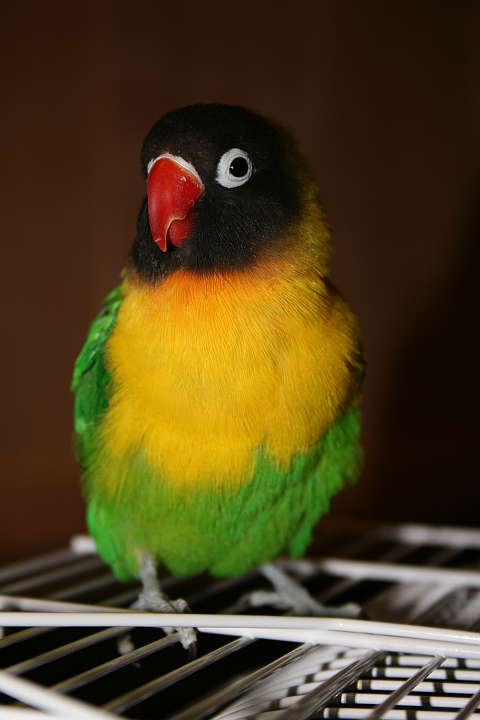 General
General
Small size, a hearty constitution and fearless personality render the Masked Lovebird an excellent choice when venturing into parrot-keeping – yet these Tanzanian natives are so engaging that they remain common in the collections of even very advanced aviculturists. Please see The Masked or Yellow-Collared Lovebird, Agapornis personata – Natural History for information on Masked Lovebirds in the wild.
Cage and Physical Environment
As with all birds, the largest enclosure possible should be chosen, with a minimum size being 36” x 36” x 18” for a pair (or slightly smaller if the birds are exercised often – Blue Ribbon Series T-10 Cage). The width between the bars should be no more than ¾ of an inch – frightened lovebirds may squeeze through wider bars that contain them when calm.
The cage should be provisioned with perches of various widths and materials, with the most-utilized perch being of a thickness that allows the birds’ feet to extend about three quarters of the way around. A birdbath should be provided.
These little dynamos should be kept busy – they have an affinity for shredding bark and should be given lots of willow, fruit tree and other non-toxic branches.
Masked Lovebirds housed in an outdoor aviary will provide you with quite a treat – they never stop exploring (or destroying any plants they get hold of!) and interacting with what is going on outside the aviary.
Light, Heat and Humidity
Having evolved in a harsh environment, Masked Lovebirds are resilient as regards temperature. On winter nights in their native Tanzania, temperatures regularly drop to 45 F, and sometimes lower. Properly acclimated birds have been over-wintered outdoors in England (they are provided with a dry, frost-free shelter). They are, however, sensitive to moisture, and will not thrive if allowed to become damp and chilled.
An average humidity of 60% or so is ideal, but drier is fine except in the case of breeding pairs (please see below).
Masked Lovebirds kept indoors should be provided with a full spectrum bulb, such as the Zoo Max Avian Sun UVB Bulb.
Feeding
Despite their rather outsized beaks, the majority of the Masked Lovebird’s diet should be composed of a small seeds, such as canary and white and yellow millet, along with a bit of hemp and sunflower (Sunburst Medium Parrot Food) and a high quality pelleted food (Lafeber Daily Diet – Pellets). They favor sprouting greens (Vitakraft Sprout Pot), a variety of fruits and some vegetables (individual preferences vary). Cuttlebone and grit should always be available.
Image referenced from Wikipedia, http://en.wikipedia.org/wiki/Image:Masked_Lovebird_(Agapornis_personata)_pet_on_cage.png, uploaded by Epoulin
 That Bird Blog – Bird Care and History for Pet Birds
That Bird Blog – Bird Care and History for Pet Birds
